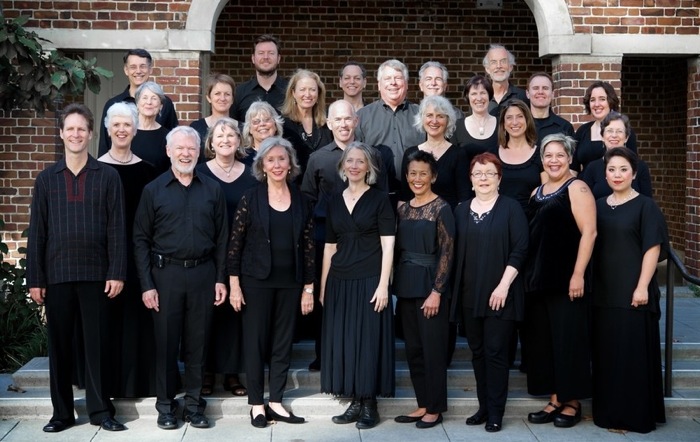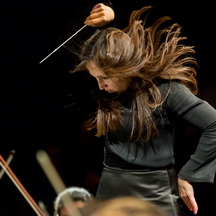Paving the way for Bach…
In a concert by the California Bach Society titled “North German Masters before Bach,” we were treated to lovely and little-known music. And that begged a fascinating question: who were the composers that inspired Bach? Paul Flight led a journey through the seventeenth century world of Tunder and Buxtehude, finding Italian influences reshaped by the Protestant Reformation, and a lovely interplay of lines that Bach would have known when he wrote his intricate fugues.
The first of the three concerts of this program opened on Friday, Feb. 24 at St Mark’s Lutheran Church in San Francisco, an ornate venue with a pristine sound, and was repeated at St Mark’s Episcopal Church in Berkeley. Spread in a long arc across the stage, the 32 singers of CBS and seven musicians on period instruments delivered the nuances of an older art form.
They began with Nisi Dominus by Franz Tunder (1614 – 1667), the organist of Lübeck’s Marienkirche. That church in Germany’s northern port became renowned for its music, thanks to the efforts of Tunder, who created its “Abendmusiken,” free concerts sponsored by the business community. In this upbeat work, tenors created a lilting line and then added quick decorations with a unity and authority that made it sound easy. The altos joined them for a richer timbre, and those 16 singers slowed for unison chords that were tight and creamy.
The two violins and two violas were silken and plaintive, tuned nearly a half step down for a sound that was authentic for that time, while the cello leaned into a rhythm that gave every line the feel of a courtly dance. Those regular bow strokes were a sea-like undercurrent that unified the quick-changing moods and modes, the “word painting” that Tunder used to mirror the emotions of the text.
And the text of Psalm 127 is surprisingly Zen-like, beginning with, “Unless the Lord built the house/Those who built it labored in vain,” an admonition to ground your foundations in the spiritual realm.
Jeffrey Fields sang the bass solo with a combination of gravelly baritone notes and a buoyant ethereality, surprisingly agile for such a rich voice, and then the chorus came together for the “Gloria” and “Amen,” full and meaty.
“That was the style of Monteverdi, transported to the North of Germany,” said Flight after the applause. “The next piece is also by Tunder and could not be more different. It is a ‘bulwark’ of the Protestant Reformation and an early example of the chorale motet.”
Set to Martin Luther’s psalm, “A mighty fortress is our God/ A bulwark never failing,” (and hence Flight’s pun), the next work opened with the strings and organ delivering what we think of as church music: big, simple harmonies and satisfying progressions, all at a sedate pace and seasoned with joy. Sopranos entered with a pure commonality of vowels, tone and timing that made their notes feel sourceless.
Other voices layered in, and those vocal lines criss-crossed in a weave that foreshadowed the more complex fugues of Bach. The basses answered, solid in their own solo despite its low register and decorative runs.
They followed with “Jesu, meines Lebens Leben” by Dietrich Buxtehude, the organist who was invited to follow Tunder as chief organist of the Marienkirche… on condition that he marry Tunder’s daughter. Which he did! That work had a deceptive simplicity and deep veins, with string passages alternating with voices in Baroque interplay.
They continued with a lovely duet for soprano and alto voices by Johann Schop, a powerful and wide-ranging work by Matthias Weckmann, and a youthful offering by Georg Phillip Telemann, giving us a taste of the rich musical scene as Bach found it.
…while paving a path for peace.
Late that same night I wondered about the lives of these lesser-known composers and followed up on Flight’s remark about the Reformation. That long tug of war between the Catholic Church and the Protestant adherents of Luther culminated in the Thirty Years War, a bitter conflict about power, the right of self-rule, and the right to practice one’s own religion. It pitted brother against brother and claimed the lives of 20% to 40% of the population of Germany – basically every able man between 20 and 40!
And musicians would have had to walk a particularly awkward line, as the Church was their usual employer and they had to lead the psalms of their congregations without offending others. Tunder was two years old when that war began and 32 when it ended. He travelled and studied in Venice before returning to Germany and one could hear both the Italian and Lutheran influences in this concert.
One wonders what it would have been like to spend one’s entire upbringing and professional life in a state of war, but if one pays attention to the lyricism of Tunder’s vocal lines and the care with which he joins those line back together into rich harmonies, it may be that he was trying to find his own musical answers to the hell of war. Perhaps he is telling us that we each have a voice and that it can be beautiful, and we can say very different things, and that when we come together we can choose harmony instead of conflict.
This is not so far-fetched. Conductor Daniel Barenboim and Palestinian philosopher Edward Said founded an Israeli-Arab youth orchestra with a powerful premise that applies to orchestras and perhaps to states: namely that we have the obligation to express ourselves as fully and beautifully as we can, and to do this while listening to each other with everything we have. This was their path for a famed orchestra and perhaps for peace and resolution.
Now each day one can open the paper and read how Trump is fanning the flames of conflict by making us fear each other’s voices instead of building on our wonderful diversity. Tunder saw where that path led four hundred years ago, and watched a generation die. But then he created music that was filled with both the ornate melismas of Catholicism and the sturdy bones of Lutheran doxology.
Bach did indeed stand on the shoulders of giants. Its time for us to lean on them, too.
—Adam Broner
Photo below, of the Cal Bach Society, photo courtesy of Cal Bach.

